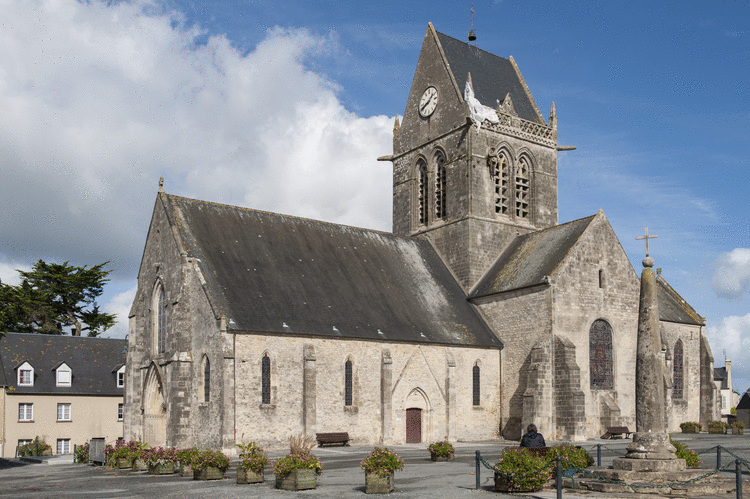John Steele is famous for hanging off of the side of the church steeple in Sainte Mere-Eglise after he got stuck around 1am on the night of 5th-6th June 1944. At this time he was participating in Operation Overlord and as a member of the airborne forces, his overall mission was to help take the German forces from behind, helping those who were storming the beach to succeed. Unfortunately, the pilot flying the plane John was on dropped him and the other members of his company at the wrong landing spot, resulting in members of his company being shot before they even hit the ground. John himself was wounded on his descent, most likely from his foot being cut by a piece of still and found himself hanging from the steeple of the church of Sainte Mere Eglise. After remaining silent as possible, playing dead so as to not be noticed, for three hours Steele was finally spotted hanging from one of the sculptures adorning the church by two German soldiers. These soldiers cut the American down and took him, prisoner, where he escaped a few days later. After this he returned to the Allied Forces and allowed his foot to heal, then he resumed his normal duties as a soldier.
However, the story of John Steele is even more exciting now than when it occurred, at the time not many people knew about the incident. John's story was originally told in a book entitled "The Longest Day", published in November of 1959, which was later adapted for the big screen. This movie sent Steele into the limelight as an American war hero. Today there is still a dummy hanging from Sainte Mere-Eglise to represent the hours that John Steele spent hanging from the church. Steele and his story represent the efforts of the American troops to win the war and their extreme bravery and dedication that define the American military effort during World War Two.
Sources
https://www.normandyamericanheroes.com/blog/sainte-m%C3%A9re-eglise-paratrooper-john-steele
http://www.airborne-museum.org/en/at-the-heart-of-history/portraits/john-m-steele/
http://en.normandie-tourisme.fr/sainte-mere-eglise-565-2.html


Nice post, Alex! I think this is a very interesting narrative about one person in the war. Perhaps the reason that this story was not well-known during the war was that allowing the public to hear about something as sad as this would have hindered the war effort. Instead, people knew many stories about the success of the United States in the war, which helped garner a sense of nationalism and support for the war. Many of the horrors of the war were only made known to the public after the end of the war. The United States enacted censorship of these stories and other anti-war sentiments out of necessity. The home front was too important to the war to allow the spread of anti-war sentiment.
ReplyDeletehttp://www.pbs.org/thewar/at_home_communication_news_censorship.htm
It's fascinating how even after facing such tough adversity, Steele was able to not only survive but continue to serve in the army. His fierce determination to win the war reminds me of the American government's goal to instill a sense patriotism in its citizens. The agency tasked with this job was the United States Office of War Information, which urged Americans to participate in the war effort through various types of media such as movies, radio, and posters. Citizens were also encouraged to buy war bonds, loans to the government that would help fund the war effort.
ReplyDeleteSource:
https://www.warhistoryonline.com/world-war-ii/american-propaganda-world-war-ii.html